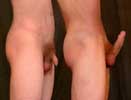Encyclopaedia Anatomica – 2005
Through its reflections upon the spectator’s relationship to themselves and that termed ‘culture’ Yeadon’s art has very human concerns at its core. It is an art that views the paradoxes of life, e.g. those relationships of the public and the private, the sensuous and the intellectual (life’s grist), through the prism of the comic and the satirical. Via these tropes the presumed nature of human existence as seen in the western cultural tradition, its qualities of being ’fallen’ or ‘tragic’, are subsequently intensified through the subversive workings of a knowing wit and pathos.
Although primarily visual Yeadon’s work examines the relationship of this visuality to the verbal and the literary, to other ‘languages’; the ‘official’ (literary) and the ‘unofficial’ (verbal). In these ways the work has its relations to ideas of multi-speechedness and the heteroglossic and also to qualities that ultimately associate it with that interface of word and text so typical of the tradition of English art (in Yeadon’s case an ‘C18th response’ to those traditions especially). The work revels in the play with and on words, taxonomic associations and the construction of ‘anti’-narratives. The essence of Yeadon’s art is the consideration of possible and probable models of reality and of human nature.
This art gleefully celebrates its own self-reflexivity emphasising relationships between the spectator and the artefact. Such a mode of existence for this art necessitates a knowing viewer, or requests the development of one, one complicit with the nuances of the irony at work, one able to read the signs contained for themselves. These signs bear a different set of relationships to those normally associated with the forms on display, undercutting the conventions of reading normally attached to them in their relations to the objective world. In this way any charges of ‘obscenity’ (or even ‘blasphemy’) levelled against the content of the work are diffused. The interface between this world of potentially subversive forms and ‘real world’ meaning is the body, a conscious textualisation of the physical, the fugitive, the fragile and the marginal. These bodily terms are not fixed and assured. They are terms liable to hybridity and corruption, made grotesque in their multiplicity of potential variations on a theme or form.
It is through this metamorphic vocabulary that these bodily tropes fuse themselves with the traditions of the mythic especially, but they can also be connected to traditions of the allegorical and even the emblematic. Considered within these latter categories they can become condensed ‘symbols’ that contain within themselves the undercurrents of human desire and attachment. Through their visual juxtapositions and correspondences they produce alignments of form that actively create ‘narrative’. Such narratives provide for the possibility of the creation of dialogues with the beholder that ultimately can form a (re) creation of the beholder’s image, a reflection of a new state for them, produced via the slippage of meanings between forms/ bodies, dialogues that rebuff literal reading and undercut anticipation of formal/compositional vocabularies and arrangements.
Herein there is a sense of the body readable in the world set against a view of the body as a world – the macrocosm and the microcosm. This is a materialism whose substance provides interfaces of legibility, interfaces between systems of naming. The metre of these pieces is however the satirical and the arch, a diffusion of expected seriousness in representation by means of ambivalence. Yeadon’s work makes use of visual terms chosen to confront the paradoxes of interpretation and of life itself i.e. ‘the beautiful’ and ‘the ugly’; ‘the intriguing’ and ‘the threatening’; ‘the sacred’ and ‘the profane’; ‘the profound’ and ‘the trivial’. Such connections place the beholder on uncertain ground, put them in a position equivalent to listening to a joke “Will I get it, should I laugh even if I don’t get it?” Similarly these images dwell upon related interfaces of recognition and alignments of this recognition with ones own views or personal sensibilities – “How do I see and understand what I see; in what terms do I define this/these? What does this say about me? Do I want to ask/answer these questions?”
Yeadon’s work attempts to refocus the terms of understanding (in ways similar to those employed by Hogarth through his collections of ‘similar objects’ in his Analysis of Beauty series), through a viewing of details (literal disconnections of object from context in Yeadon’s work), terms isolated from their real world referents. The challenge of Yeadon’s work to the beholder is to reframe their points of reference, their capacities for association and truth making. In essence, when seen in these contexts, Yeadon’s work takes on the character of a mythopoesis, reappraisals of ‘truths’, ones actual, relative and constructed. That represented in these works are not the things themselves but facsimiles of things, variations on themes, reproductions that allow the forms contained to exist in other (virtual) lives divorced from their original significance. These form’s ‘private lives’ are our encouraged misreadings. The tragic/comedic nature of our existence is mirrored in the versions of reality that these forms enact.
Alan Boulton, July 2005

